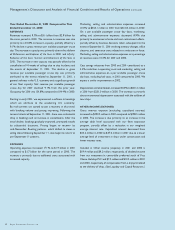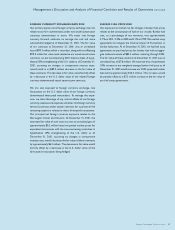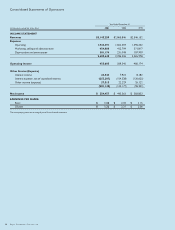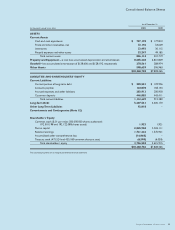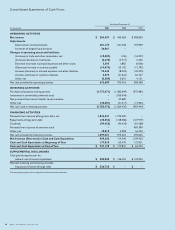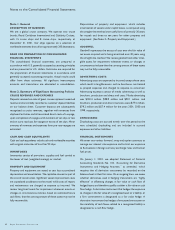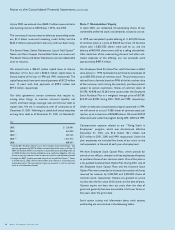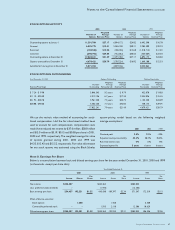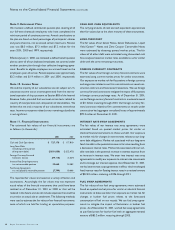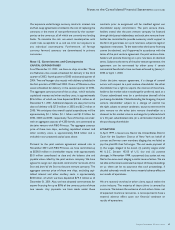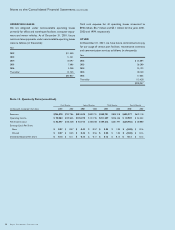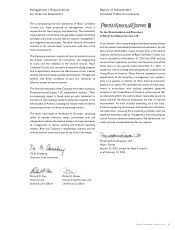Royal Caribbean Cruise Lines 2001 Annual Report Download - page 44
Download and view the complete annual report
Please find page 44 of the 2001 Royal Caribbean Cruise Lines annual report below. You can navigate through the pages in the report by either clicking on the pages listed below, or by using the keyword search tool below to find specific information within the annual report.
Notes to the Consolidated Financial Statements
42 Royal Caribbean Cruises Ltd.
Note 1. General
DESCRIPTION OF BUSINESS
We are a global cruise company. We operate two cruise
brands, Royal Caribbean International and Celebrity Cruises,
with 15 cruise ships and 8 cruise ships, respectively, at
December 31, 2001. Our ships operate on a selection of
worldwide itineraries that call on approximately 200 destinations.
BASIS FOR PREPARATION OF CONSOLIDATED
FINANCIAL STATEMENTS
The consolidated financial statements are prepared in
accordance with U.S. generally accepted accounting principles
and are presented in U.S. dollars. Estimates are required for
the preparation of financial statements in accordance with
generally accepted accounting principles. Actual results could
differ from these estimates. All significant intercompany
accounts and transactions are eliminated in consolidation.
Note 2. Summary of Significant Accounting Policies
CRUISE REVENUES AND EXPENSES
Deposits received on sales of guest cruises represent unearned
revenue and are initially recorded as customer deposit liabilities
on our balance sheet. Customer deposits are subsequently
recognized as cruise revenues, together with revenues from
shipboard activities and all associated direct costs of a voyage,
upon completion of voyages with durations of ten days or less
and on a pro rata basis for voyages in excess of ten days. Minor
amounts of revenues and expenses from pro rata voyages are
estimated.
CASH AND CASH EQUIVALENTS
Cash and cash equivalents include cash and marketable securities
with original maturities of less than 90 days.
INVENTORIES
Inventories consist of provisions, supplies and fuel carried at
the lower of cost (weighted-average) or market.
PROPERTY AND EQUIPMENT
Property and equipment are stated at cost less accumulated
depreciation and amortization. We capitalize interest as part of
the cost of construction. Significant vessel improvement costs
are capitalized as additions to the vessel, while costs of repairs
and maintenance are charged to expense as incurred. We
review long-lived assets for impairment whenever events or
changes in circumstances indicate, based on estimated future
cash flows, that the carrying amount of these assets may not be
fully recoverable.
Depreciation of property and equipment, which includes
amortization of vessels under capital leases, is computed using
the straight-line method over useful lives of primarily 30 years
for vessels and three to ten years for other property and
equipment. (See Note 4 – Property and Equipment.)
GOODWILL
Goodwill represents the excess of cost over the fair value of
net assets acquired and is being amortized over 40 years using
the straight-line method. We review goodwill and other intan-
gible assets for impairment whenever events or changes in
circumstances indicate that the carrying amount of these assets
may not be fully recoverable.
ADVERTISING COSTS
Advertising costs are expensed as incurred except those costs
which result in tangible assets, such as brochures, are treated
as prepaid expenses and charged to expense as consumed.
Advertising expenses consist of media advertising as well as
brochure, production and direct mail costs. Media advertising
was $103.4 million, $98.9 million and $93.1 million, and
brochure, production and direct mail costs were $77.5 million,
$79.2 million and $57.4 million for the years 2001, 2000 and
1999, respectively.
DRYDOCKING
Drydocking costs are accrued evenly over the period to the
next scheduled drydocking and are included in accrued
expenses and other liabilities.
FINANCIAL INSTRUMENTS
We enter into various forward, swap and option contracts to
manage our interest rate exposure and to limit our exposure
to fluctuations in foreign currency exchange rates and bunker
fuel prices.
On January 1, 2001, we adopted Statement of Financial
Accounting Standards No. 133, “Accounting for Derivative
Instruments and Hedging Activities,” as amended, which
requires that all derivative instruments be recorded on the
balance sheet at their fair value. On an ongoing basis, we assess
whether derivatives used in hedging transactions are “highly
effective” in offsetting changes in fair value or cash flow of
hedged items and therefore qualify as either a fair value or cash
flow hedge. A derivative instrument that hedges the exposure
to changes in the fair value of a recognized asset or a liability, or
a firm commitment is designated as a fair value hedge. A
derivative instrument that hedges a forecasted transaction or
the variability of cash flows related to a recognized liability is
designated as a cash flow hedge.


